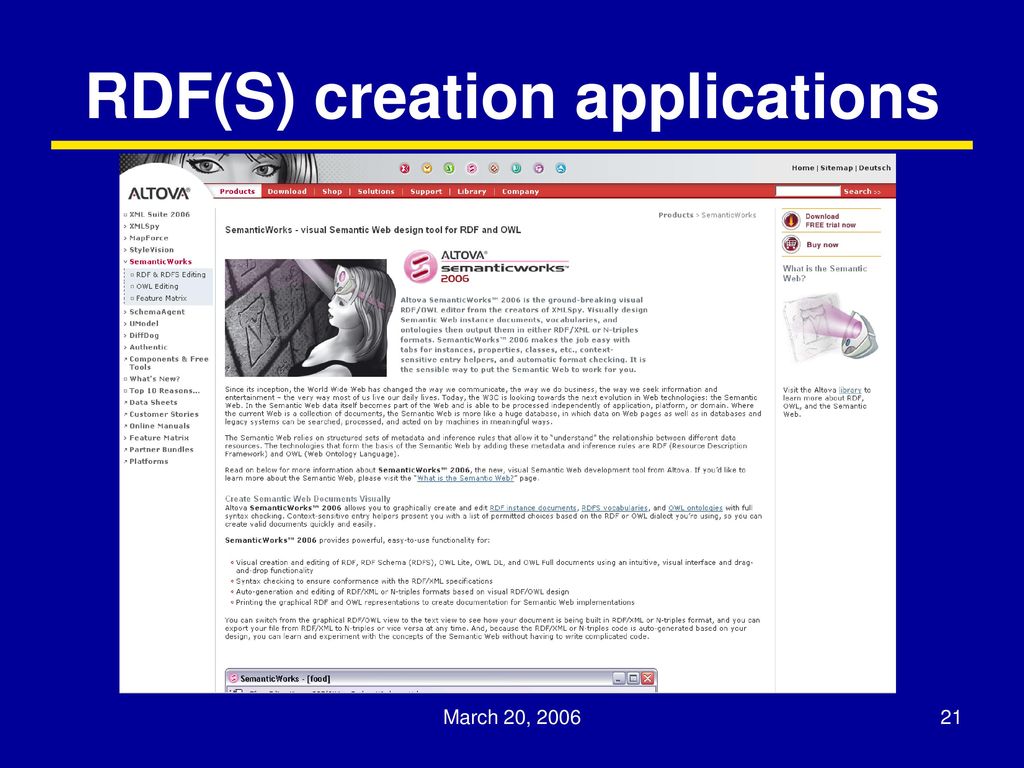Altova Semanticworks 2009 Free Download

All Altova software licenses available via the GSA Schedule include (1) or (2) years of. DiffDog® 2011 Enterprise Edition, SchemaAgent® 2011, SemanticWorks®. For a free 30-day trial of any of our products, simply download the software you. By version 2009 and corresponding related versions from the 2009 cycle.
Download pixies discography rar free version. SOURCE: Altova February 23, 2009 10:08 ET Altova XMLSpy 2009 Extends Its Functionality Adding Support for XBRL and More XMLSpy 2009 Delivers Support for XBRL, Intelligent XPath Auto-Completion, Native Support for Additional Databases, and More BEVERLY, MA--(Marketwire - February 23, 2009) - Altova® (), creator of XMLSpy®, the industry leading recently announced the availability of XMLSpy Version 2009 (v2009). Available as a stand alone product or as part of the Altova MissionKit®, an integrated suite of XML, database, and UML tools, Altova XMLSpy 2009 delivers a host of new functionality, including support for XBRL validation and taxonomy editing, intelligent XPath auto-completion, native database support for SQL Server® 2008, Oracle® 11g, and PostgreSQL 8, expanded source code control support, and more.

'With the release of XMLSpy 2009 powerful new features have been added to our already feature-rich XML editor, providing users with increased flexibility for working with XML technologies such as XPath and XML Schema. Version 2009 also delivers functionality attractive to companies throughout the world that are tackling the enormous task of complying with recent XBRL mandates,' said Alexander Falk, President and CEO for Altova. 'Technical users in these organizations need cost-effective tools for validating XBRL filings, extending industry-standard XBRL taxonomies, and more. By adding XBRL support to XMLSpy 2009, as well as other products in our MissionKit tool suite, Altova users can continue using the same cost-effective, graphical tools they are familiar with to ease into XBRL compliance.' Some of the new features now available in Altova XMLSpy 2009 include: -- Support for XBRL Standards - XMLSpy 2009 includes a new engine for validating documents based on XBRL 2.1 and XBRL Dimensions 1.0. This new feature allows users to view and analyze XBRL taxonomies as well as validate XBRL instance documents against taxonomies. XBRL linkbases can also be validated against their associated schema file.
Note: XBRL validation is also supported in AltovaXML® 2009, the free XML standards processor, providing developers with a royalty-free XBRL validator for use in their applications. -- XBRL Taxonomy Editor - A powerful, graphical XBRL taxonomy editor is now available in XMLSpy 2009. Using the same editing paradigm as the popular XMLSpy graphical XML Schema editor, the XBRL taxonomy editor organizes taxonomy components on easy-to-filter tabs and provides informative icons, mouseover messages, detail windows, and context-sensitive entry helpers to help users both view and understand existing taxonomies, and create new ones by way of extension. -- XPath Auto-Completion - Intelligent auto-completion of XPath expressions is also provided in XMLSpy 2009. As a developer is composing an XPath expression, XMLSpy provides a drop-down entry helper menu with valid XPath functions, as well as element and attribute names from the associated schema and XML instance(s). XPath auto-completion simplifies XPath composition and complements the XMLSpy XPath Analyzer functionality, making XMLSpy even more powerful for XSLT, XQuery, and XML Schema development.
-- Extended Database Support - Adding to its long list of natively supported databases, XMLSpy 2009 now supports the latest versions of SQL Server® and Oracle®: SQL Server 2008 and Oracle 11g. Native support has also been added for the PostgreSQL 8 database. Additionally, new functionality for viewing and editing XML fields is provided for SQL Server 2005 and 2008. When a SQL Server database field contains an XML document, users can now view and edit it with full validation and well-formedness checking. XMLSpy 2009 also supports registering and/or dropping XML Schemas in the database, as well as viewing and editing them in Graphical XML Schema View. -- Extensions for Editing XML Schema Identity Constraints - XMLSpy provides multiple features for this important aspect of XML Schema development; and Version 2009 gives users the ability to visualize the schema identity constraints and underlying relationships, as well as a graphical means to edit them in the visual. Identity constraints are now indicated by green lines, informative icons, and mouse-over messages in the Content Model View.